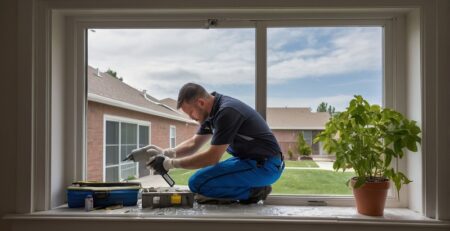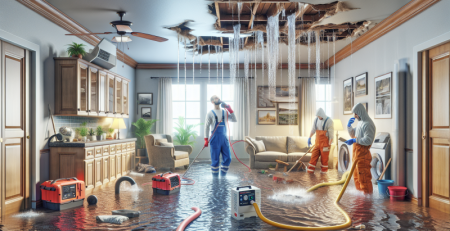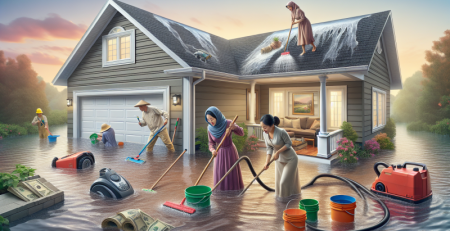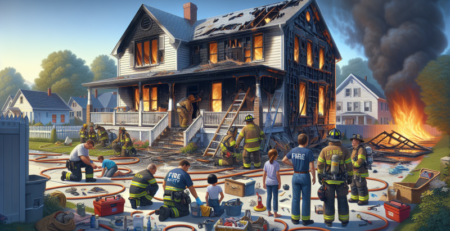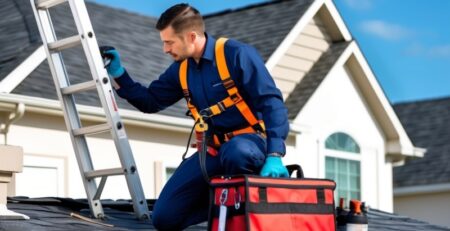How to Create a Fire Safety Plan for Your Family
Creating a fire safety plan for your family is an essential step in ensuring the safety and well-being of your loved ones. With the increasing risks of fire incidents in homes, having a comprehensive fire safety plan can make all the difference in an emergency. At Kraus Restoration, NJ’s leaders in water, mold, and fire damage restoration, we understand the importance of preparedness. Our team of IICRC certified experts is dedicated to helping families in Central and Northern NJ develop effective strategies to prevent and respond to fire emergencies. In this guide, we will walk you through the key components of a fire safety plan, including escape routes, communication strategies, and the importance of regular drills. Remember, being proactive can save lives—so let’s get started on creating a fire safety plan that ensures your family is ready for any situation. For immediate assistance or expert advice, don’t hesitate to call us at (973) 886-2021.
Understanding the Importance of a Fire Safety Plan
Creating a fire safety plan is essential for every family, as it can mean the difference between life and death in the event of a fire. Understanding the importance of such a plan is crucial for ensuring the safety of your loved ones and protecting your property. Fires can spread rapidly, and having a well-thought-out fire safety plan can help you respond effectively and efficiently when every second counts.
According to the National Fire Protection Association (NFPA), a fire department responds to a fire somewhere in the United States every 24 seconds. This alarming statistic underscores the reality that fires are a common occurrence, and being prepared is vital. A fire safety plan provides a structured approach to preventing fires, ensuring safe evacuation, and minimizing damage.
One of the key components of a fire safety plan is prevention. By identifying potential fire hazards in your home, you can take proactive measures to reduce the risk of a fire starting. This includes regularly checking smoke detectors, ensuring that electrical systems are up to code, and being cautious with flammable materials. As the NFPA states, "Working smoke alarms cut the risk of dying in reported home fires in half." Regular maintenance and awareness can significantly enhance your family’s safety.
In addition to prevention, a fire safety plan must include clear evacuation routes. In the event of a fire, every family member should know how to exit the home quickly and safely. This involves identifying multiple escape routes from each room and ensuring that these paths are free of obstructions. Practicing fire drills can help reinforce these routes and ensure that everyone knows what to do in an emergency. As the NFPA emphasizes, "Having a fire escape plan is essential for your family’s safety."
Communication is another critical aspect of a fire safety plan. Families should establish a designated meeting place outside the home where everyone can gather after escaping. This helps ensure that all family members are accounted for and reduces the risk of anyone re-entering the home to search for others. Additionally, it is important to discuss the plan with all family members, including children, so that everyone understands their roles and responsibilities during a fire emergency.
Moreover, a fire safety plan should include information about how to contact emergency services. Knowing the local emergency number and having a charged phone readily available can save precious time during a crisis. It is also advisable to keep a list of important contacts, including neighbors, who can assist in an emergency.
Incorporating fire safety education into your family’s routine can further enhance your preparedness. Teaching children about fire safety, including the dangers of playing with matches or lighters, can instill a sense of responsibility and awareness. Resources such as the NFPA’s "Sparky the Fire Dog" program provide engaging ways to educate children about fire safety.
In conclusion, a fire safety plan is not just a document; it is a vital strategy for protecting your family and home. By understanding the importance of prevention, evacuation, communication, and education, you can create a comprehensive fire safety plan that prepares your family for the unexpected. Remember, "It is better to be prepared and not need it than to need it and not be prepared." For more information on fire safety and restoration services, visit fire cleanup or learn about our services to ensure your home is safe and secure. For any inquiries or assistance, feel free to contact us.
Assessing Your Home for Fire Hazards
Creating a fire safety plan for your family begins with a thorough assessment of your home for potential fire hazards. Understanding the risks present in your living environment is crucial for preventing fires and ensuring the safety of your loved ones. Start by examining the areas in your home where fires are most likely to ignite. The kitchen is often the most common source of household fires, so pay close attention to appliances, cooking practices, and flammable materials. Ensure that your stove, oven, and other cooking devices are in good working order and that you never leave them unattended while in use. Additionally, keep flammable items such as dish towels, paper products, and cooking oils away from heat sources.
Next, evaluate your electrical systems. Faulty wiring, overloaded circuits, and damaged cords can all pose significant fire risks. Inspect your outlets and extension cords for any signs of wear or damage, and avoid using too many devices on a single outlet. If you notice any issues, consider contacting a professional electrician to address them. Furthermore, ensure that your smoke detectors are installed in key areas of your home, such as the kitchen, hallways, and bedrooms. Regularly test these devices to ensure they are functioning correctly and replace the batteries at least once a year.
Another critical area to assess is your storage practices. Flammable materials such as gasoline, cleaning supplies, and paints should be stored safely and away from heat sources. Use appropriate containers and keep these items in well-ventilated areas. Additionally, decluttering your home can significantly reduce fire hazards. Piles of paper, clothing, and other materials can fuel a fire and make it spread more quickly. Regularly clean and organize your living spaces to minimize these risks.
Consider the exterior of your home as well. Overgrown vegetation, debris, and poorly maintained roofs can all contribute to fire hazards. Keep your yard clear of dead leaves and branches, and ensure that your gutters are clean to prevent the buildup of flammable materials. If you live in an area prone to wildfires, creating a defensible space around your home by clearing away brush and using fire-resistant landscaping can be a vital step in protecting your property.
Finally, take the time to educate your family about fire safety. Discuss the importance of fire prevention and what to do in case of a fire. Conduct regular fire drills to ensure everyone knows the escape routes and meeting points. By involving your family in the assessment process, you can foster a culture of safety and preparedness.
In summary, assessing your home for fire hazards is a proactive step in creating a comprehensive fire safety plan for your family. By identifying potential risks in your kitchen, electrical systems, storage practices, and outdoor areas, you can take the necessary precautions to minimize the likelihood of a fire. Regular maintenance, education, and open communication about fire safety can significantly enhance your family’s preparedness and safety. For more information on fire safety and restoration services, visit fire cleanup or explore our about page to learn more about our commitment to safety and restoration. If you have any questions or need assistance, feel free to contact us.
Developing an Escape Route for Your Family
Creating a fire safety plan for your family is essential to ensure everyone’s safety in the event of a fire. One of the most critical components of this plan is developing an effective escape route. An escape route is a predetermined path that your family will take to exit your home quickly and safely during a fire emergency. To create a successful escape route, start by assessing your home’s layout. Identify all possible exits, including doors and windows, and ensure they are easily accessible. It is vital to have multiple escape routes from each room, especially from bedrooms, as smoke can quickly fill a space and limit visibility.
Next, practice your escape route with your family. Conduct regular fire drills to familiarize everyone with the plan. During these drills, ensure that all family members know how to reach the nearest exit and where to meet outside the home after escaping. Choose a safe meeting point that is a safe distance away from the house, such as a neighbor’s yard or a designated tree. This meeting point is crucial for ensuring that everyone is accounted for after the evacuation.
In addition to practicing the escape route, consider the specific needs of each family member. For example, if you have young children, elderly relatives, or individuals with mobility challenges, make sure that the escape route accommodates their needs. You may need to designate an adult to assist those who require help during an evacuation. It is also important to ensure that all exits are clear of obstacles and that doors and windows can be opened easily. Regularly check that smoke alarms are functioning and that everyone knows how to respond if they hear the alarm.
Another important aspect of your escape route is communication. Make sure that all family members understand the fire safety plan and the importance of staying calm during an emergency. Discuss what to do if a fire occurs, including not using elevators and staying low to the ground to avoid smoke inhalation. Encourage family members to memorize the escape routes and to practice them frequently.
In addition to developing an escape route, consider the use of fire safety equipment. Ensure that smoke detectors are installed in every room and that they are tested monthly. Having a fire extinguisher readily available and knowing how to use it can also be beneficial. Educate your family on the different types of fires and the appropriate methods for extinguishing them.
Lastly, keep your fire safety plan updated. As your family grows or changes, so too should your escape routes and safety plans. Regularly review and practice your fire safety plan to ensure that everyone remains prepared. If you are looking for more information on fire safety or need assistance with fire cleanup, you can visit our fire cleanup services page. For additional resources on creating a comprehensive safety plan, feel free to check out our about us section. Remember, being prepared can make all the difference in a fire emergency, so take the time to develop and practice your escape route with your family.
Establishing a Meeting Place After Evacuation
After an evacuation due to a fire, it is crucial for families to have a designated meeting place. This location serves as a safe spot where all family members can gather to ensure everyone is accounted for. Establishing a meeting place is a vital component of a comprehensive fire safety plan, as it minimizes confusion and anxiety during a stressful situation. When selecting a meeting place, consider choosing an area that is a safe distance from your home, ideally at least 100 feet away. This distance helps ensure that you are out of harm’s way from any potential fire hazards or smoke.
The meeting place should be easily accessible and recognizable to all family members. It could be a neighbor’s house, a nearby park, or a specific landmark that everyone knows. It is essential to discuss this location with all family members and practice the evacuation plan regularly. This practice will help reinforce the importance of the meeting place and ensure that everyone knows where to go in case of an emergency.
In addition to selecting a meeting place, it is important to establish a communication plan. In the event of a fire, family members may be separated, and having a way to communicate can provide peace of mind. Designate a family member or friend who lives outside the immediate area as a point of contact. This person can help relay information and ensure that everyone is safe. Make sure that all family members have the contact information for this person saved in their phones or written down in a safe place.
Regularly review and update your fire safety plan, including the meeting place and communication strategies. Changes in your family dynamics, such as new members or changes in residence, may require adjustments to your plan. Additionally, if your meeting place is no longer accessible due to construction or other factors, it is essential to choose a new location promptly.
Incorporating these elements into your fire safety plan not only enhances your family’s preparedness but also fosters a sense of security. Knowing that there is a clear plan in place can alleviate some of the stress associated with fire emergencies. For more information on creating a comprehensive fire safety plan, you can explore our about page or check out our fire cleanup services. It is never too early to start planning and ensuring your family’s safety in the event of a fire.
Educating Your Family on Fire Safety Procedures
Educating your family on fire safety procedures is a crucial step in creating an effective fire safety plan. Understanding the potential dangers of fire and knowing how to respond can save lives and minimize property damage. Start by discussing the importance of fire safety with your family members, emphasizing that fire can spread rapidly and that every second counts in an emergency. Make sure everyone knows the sound of the smoke alarm and understands that they should take it seriously. Conduct regular fire drills so that everyone knows the escape routes and the meeting point outside the home. This practice not only helps in memorizing the escape plan but also reduces panic during an actual emergency.
Next, teach your family about the different types of fire extinguishers and how to use them. Familiarize them with the PASS technique: Pull the pin, Aim low, Squeeze the handle, and Sweep from side to side. Ensure that everyone knows where the fire extinguishers are located in your home and that they are easily accessible. Additionally, educate your family on the various causes of fires, such as cooking accidents, electrical malfunctions, and improper use of candles. Discuss safe practices, such as never leaving cooking unattended and keeping flammable materials away from heat sources.
It is also important to create a family emergency contact list that includes local fire department numbers and other emergency services. Make sure this list is easily accessible, perhaps on the refrigerator or in a shared digital format. Encourage open communication about fire safety, allowing family members to express any concerns or questions they may have. This dialogue can help reinforce the importance of being prepared and can lead to a more comprehensive understanding of fire safety.
Consider involving your children in the process of creating the fire safety plan. This can make them feel more invested and responsible for their safety. Use age-appropriate language and activities to teach them about fire safety. For younger children, you might use stories or games to illustrate the importance of fire safety, while older children can be involved in more detailed discussions about emergency procedures.
Regularly review and update your fire safety plan as needed. Changes in your living situation, such as moving to a new home or renovations, may require adjustments to your escape routes or safety measures. Keeping your family informed about these changes ensures that everyone remains prepared. You can also take advantage of community resources, such as local fire department programs that offer fire safety education and resources.
In addition to home safety, educate your family about fire safety outside the home. Discuss the importance of being cautious during outdoor activities, such as grilling or using fireworks. Make sure everyone understands the local regulations regarding outdoor fires and the importance of maintaining a safe distance from flammable materials.
Finally, consider the benefits of professional fire safety training. Many organizations offer courses that cover essential fire safety skills, including how to respond in case of a fire, first aid, and evacuation procedures. These courses can provide valuable knowledge and skills that can enhance your family’s preparedness.
By prioritizing fire safety education within your family, you are taking proactive steps to protect your loved ones and your home. For more information on fire safety and restoration services, visit fire cleanup or explore our about page to learn more about our commitment to safety and preparedness. Remember, a well-informed family is a safer family, and being prepared can make all the difference in an emergency.
Regularly Practicing Fire Drills
Regularly practicing fire drills is a crucial component of any effective fire safety plan for your family. These drills not only prepare everyone for the possibility of a fire but also help to instill a sense of confidence and awareness in each family member. The importance of routine fire drills cannot be overstated, as they ensure that everyone knows exactly what to do in the event of a fire emergency.
To begin with, it is essential to establish a clear fire escape plan that outlines the safest routes out of your home. This plan should be communicated to all family members, including children, elderly relatives, and pets. Once the escape routes are determined, it is vital to practice these routes regularly. During your fire drills, simulate different scenarios, such as a fire occurring at night or in a specific room, to help family members understand how to react in various situations. This practice will help everyone remain calm and collected during an actual emergency.
In addition to practicing escape routes, it is important to designate a safe meeting place outside your home where everyone can gather after escaping. This meeting point should be a location that is easily accessible and away from the house, such as a neighbor’s yard or a nearby tree. During your fire drills, ensure that everyone knows where this meeting place is and that they understand the importance of going there immediately after escaping the house. This practice not only helps to account for everyone but also prevents confusion and panic during a real emergency.
Another key aspect of fire drill practice is to incorporate the use of smoke alarms and fire extinguishers. Teach family members how to recognize the sound of smoke alarms and what actions to take when they hear them. Additionally, familiarize everyone with the location of fire extinguishers in your home and demonstrate how to use them properly. This knowledge can be invaluable in preventing a small fire from escalating into a larger disaster.
It is also beneficial to involve your children in the fire drill process. Encourage them to take an active role in the drills by assigning them specific tasks, such as checking smoke alarms or leading the way to the meeting point. This involvement not only makes the drills more engaging for children but also reinforces the importance of fire safety in their minds. By empowering them with knowledge and responsibility, you are helping to create a culture of safety within your family.
Regularly scheduled fire drills should be conducted at least twice a year, but more frequent practice can be beneficial, especially if there are changes in your household, such as new family members or changes in the layout of your home. After each drill, take the time to discuss what went well and what could be improved. This reflection allows for continuous improvement of your fire safety plan and ensures that everyone remains informed and prepared.
In addition to practicing at home, consider participating in community fire safety programs or workshops. Many local fire departments offer resources and training sessions that can enhance your family’s fire safety knowledge. Engaging with your community not only provides valuable information but also fosters a sense of collective responsibility for fire safety.
Ultimately, regularly practicing fire drills is an essential part of creating a comprehensive fire safety plan for your family. It ensures that everyone knows how to respond quickly and effectively in the event of a fire, reducing the risk of injury and increasing the chances of a safe escape. By incorporating these practices into your family routine, you are taking proactive steps to protect your loved ones and your home. For more information on fire safety and restoration services, visit our fire cleanup page or learn more about our services. If you have any questions or need assistance, please feel free to contact us.
Updating Your Fire Safety Plan as Needed
Creating a fire safety plan for your family is a crucial step in ensuring the safety and well-being of your loved ones. However, it is equally important to recognize that a fire safety plan is not a one-time task. As your family dynamics change, your living environment evolves, and new fire hazards emerge, it becomes necessary to update your fire safety plan regularly. This proactive approach will help you stay prepared and ensure that everyone knows what to do in the event of a fire.
One of the primary reasons to update your fire safety plan is changes in your household. If you have welcomed new family members, such as infants, elderly relatives, or pets, it is essential to reassess your plan. Each individual may have different needs and abilities when it comes to evacuating during an emergency. For instance, if you have a baby, you will need to consider how to safely evacuate with a stroller or car seat. Similarly, if you have elderly family members, you may need to plan for their mobility challenges. Regularly reviewing and updating your plan ensures that it accommodates everyone in your household.
Another important factor to consider is changes in your home. If you have recently renovated your home, added new rooms, or changed the layout, it is vital to revisit your fire safety plan. New construction can introduce new escape routes or hazards that were not present before. For example, if you have added a basement or an attic, you need to ensure that these areas are included in your escape plan and that smoke detectors are installed in these locations. Additionally, if you have made changes to your heating or electrical systems, it is essential to assess any new risks that may have arisen.
Fire safety regulations and recommendations can also change over time. It is important to stay informed about the latest fire safety guidelines from local authorities and fire departments. These updates may include new recommendations for smoke detector placement, fire extinguisher accessibility, and evacuation procedures. By staying informed and updating your fire safety plan accordingly, you can ensure that your family is following the best practices for fire safety.
Regular drills are another critical component of maintaining an effective fire safety plan. Conducting fire drills with your family helps everyone become familiar with the escape routes and procedures. After each drill, take the time to discuss what went well and what could be improved. This feedback can help you refine your plan and make necessary adjustments. Additionally, if you have made changes to your home or family situation, it is essential to conduct drills to practice the updated plan.
It is also wise to review your fire safety plan after any significant life events, such as moving to a new home, experiencing a fire incident, or changes in your family structure. Each of these events can impact your fire safety needs and should prompt a reassessment of your plan. For instance, if you have moved to a new neighborhood, familiarize yourself with the local fire department and their resources. Understanding the specific fire risks in your area can help you tailor your plan to address those concerns.
Lastly, ensure that your fire safety equipment is regularly inspected and maintained. Smoke detectors should be tested monthly, and batteries should be replaced at least once a year. Fire extinguishers should be checked for accessibility and functionality, and you should ensure that they are placed in key areas throughout your home. If you have a fire sprinkler system, it is essential to have it inspected according to local regulations. Keeping your equipment in good working order is a vital part of your fire safety plan.
In conclusion, updating your fire safety plan as needed is an essential practice for keeping your family safe. By regularly reviewing your plan in light of changes in your household, home, and fire safety regulations, you can ensure that your family is prepared for any emergency. Conducting regular drills, staying informed about local fire safety guidelines, and maintaining your fire safety equipment will further enhance your preparedness. For more information on fire safety and restoration services, visit fire cleanup or contact us at contact for assistance in creating a comprehensive fire safety plan tailored to your family’s needs.
In conclusion, creating a fire safety plan for your family is an essential step in ensuring the safety and well-being of your loved ones. By taking the time to assess potential fire hazards, establish clear escape routes, and conduct regular fire drills, you empower your family to respond effectively in the event of an emergency. Remember to involve everyone in the planning process, as this fosters a sense of responsibility and awareness among all family members, including children. Regularly review and update your fire safety plan to adapt to any changes in your home or family dynamics. With a well-thought-out fire safety plan in place, you can have peace of mind knowing that your family is prepared to act swiftly and safely should the need arise. Stay vigilant, stay safe, and prioritize fire safety in your home.

